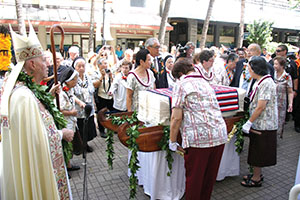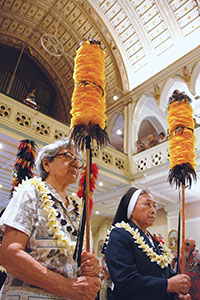In a day of celebration, the remains of St. Marianne Cope were enshrined at the Cathedral Basilica of Our Lady of Peace in Honolulu on July 31. St. Marianne is beloved on the Hawaiian Islands and far beyond, remembered for her 35 years of caring for those with Hansen's disease, or leprosy.

Bishop Clarence ‘Larry’ Silva of Honolulu prepares to lead a procession escorting the box containing the remains of St. Marianne Cope into the Cathedral Basilica of Our Lady of Peace. The box is draped with a quilted Hawaiian flag and sits atop a wooden canoe adorned with maile lei, made from the fragrant vine bestowed on those who hold positions of special honor. The Franciscan sisters standing behind the canoe ready to carry it are, from left, Sr. Davilyn Ah Chick and Sr. Patricia Schofield. The sisters in the foreground are, from left, Sr. William Marie Eleniki and Sr. Francis Regis Hadano.
Sisters of St. Francis of the Neumann Communities in Hawaii escorted St. Marianne's remains into the cathedral in a cloth-wrapped metal box atop a ceremonial canoe made from Hawaiian koa wood. Bishop Clarence "Larry" Silva celebrated the Mass.
"It was like a homecoming. She's back," said Sr. William Marie Eleniki, a Sister of St. Francis of the Neumann Communities and president of the St. Francis Healthcare Foundation of Hawaii. The congregation sponsors St. Francis Healthcare System of Hawaii.
St. Marianne died in 1918 at age 80 in Kalaupapa, on the remote island of Moloka'i, where she had labored to ease the plight of people forced to live in isolation and in primitive conditions because of their disease. St. Marianne's remains were relocated in recent years during the canonization process to her motherhouse in Syracuse, N.Y. But with the closing and relocating of the motherhouse there, the Sisters of St. Francis of the Neumann Communities thought it fitting to return her remains to Hawaii.

Sr. Miriam Cabacungan, OSF, left, and Sr. Jovita Agustin, OSF, usher in the procession with feather-adorned kahili used in traditional Hawaiian ceremonies.
St. Marianne's remains are currently enshrined in a koa wood reliquary at the cathedral. Sr. Eleniki said the basilica will be renovated with a new section to hold St. Marianne and a relic of St. Damien of Moloka'i, the Belgian Catholic priest who cared for those banished to the leprosy colony in Moloka'i and died there of the disease in 1889.
St. Marianne was the superior of her New York order, then called the Franciscan Sisters of Syracuse, when in 1883, she and six other sisters accepted an invitation from the Hawaiian kingdom to come to the islands to care for those with leprosy. She opened Malulani Hospital on Maui, now known as Maui Memorial Medical Center, and the Kapiolani Home for the healthy children of leprosy patients. In 1888, she moved to Kalaupapa to run a complex of cottages for women with Hansen's disease. In the time since, about 65 Sisters of St. Francis have continued work there as nurses and health care workers, according to the congregation. Hawaii abolished its 100-year-old isolation law in 1969, but a small number of patients still live in Kalaupapa.
Copyright © 2014 by the Catholic Health Association
of the United States
For reprint permission, contact Betty Crosby
or call (314) 253-3477.